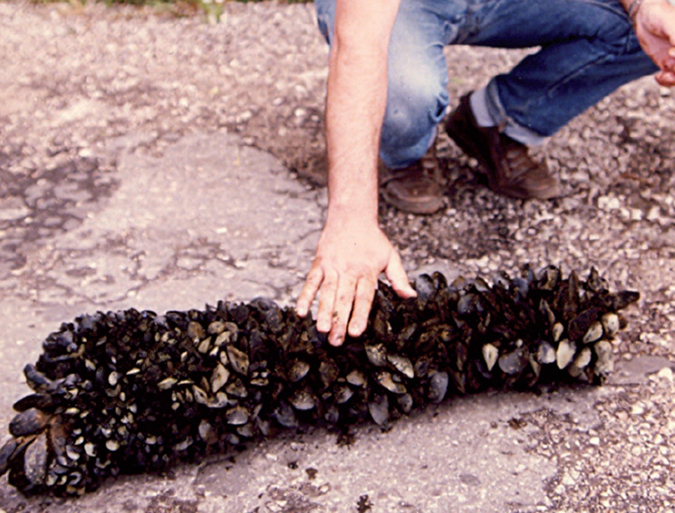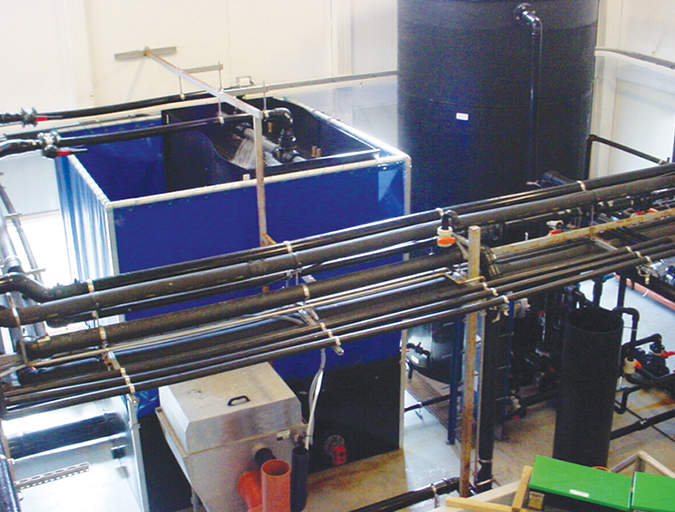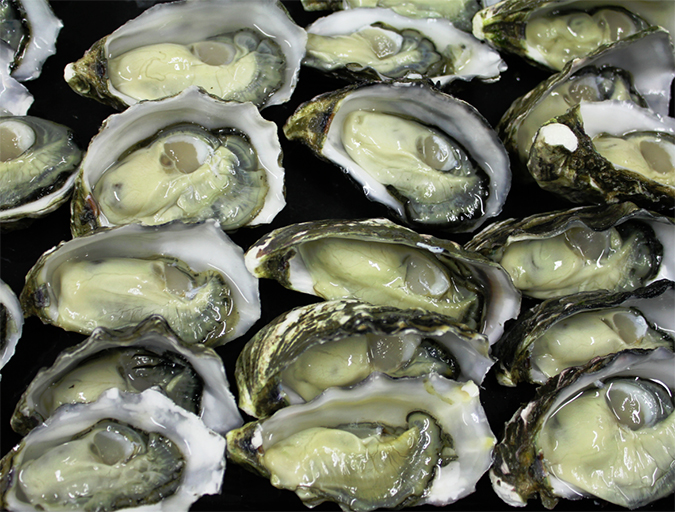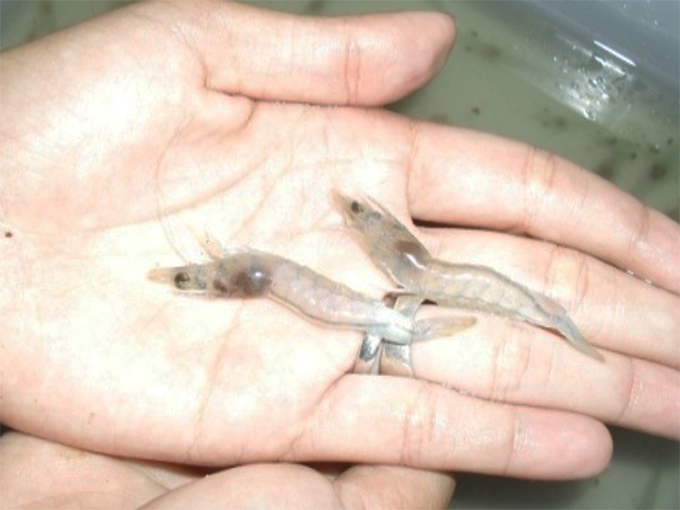Hatcheries, farms should monitor levels of essential nutrients

Concentrations of calcium and magnesium are seldom measured in waters for aquaculture, but total hardness is determined rather often. Hardness is the concentration of divalent cations — mostly calcium and magnesium — in water expressed in milligrams per liter (parts per million) of equivalent calcium carbonate.
Hardness sometimes is expressed in different forms: total hardness and calcium hardness with the difference being magnesium hardness. Calcium hardness plus magnesium hardness, of course, is total hardness. The factors for converting between hardness cations and hardness are as follows: calcium x 2.5 = calcium hardness, and magnesium x 4.12 = magnesium hardness.
The major sources of hardness in freshwater are dissolution of limestone, calcium silicate and certain feldspars. In arid regions, the dissolution of calcium and magnesium sulfates and certain other minerals is a source of calcium and magnesium. Most liming materials used in aquaculture are made from limestone, which imparts hardness to water.
In most freshwater, hardness and alkalinity are of similar concentration and range from less than 5 mg to over 150 mg/L. In arid regions, hardness usually exceeds 100 mg/L and often is greater. Hardness frequently exceeds alkalinity in arid regions.
Seawater has an average of 400 mg/L calcium and 1,350 mg/L magnesium, resulting in a hardness of over 6,000 mg/L — much more than its average alkalinity of about 140 mg/L. Estuaries usually have a lower hardness than seawater, but much greater than freshwater. Hardness concentrations vary greatly from place to place and over time in estuaries because of the mixing of seawater and freshwater in these systems.
Essential nutrients
Calcium and magnesium are essential nutrients for aquatic plants and animals. For example, fish need calcium for bone development, because bone consists largely of calcium phosphate. However, the concentrations required for phytoplankton — the most abundant plants in aquaculture ponds — are only about 2 mg/L for calcium and even less for magnesium.

Aquatic animals can get calcium and magnesium both from the water and their food. Hardness usually is great enough to supply enough calcium and magnesium for aquatic animals in fertilized ponds, and in ponds with feeding, calcium and magnesium are obtained from the feed when the hardness is low. Ponds with low-alkalinity water usually have low calcium and magnesium concentrations, and when liming materials are applied to remedy this problem, hardness also increases.
Freshwater ponds in arid regions and ponds filled with estuarine water or seawater usually have plenty of hardness for aquaculture. When such ponds are limed, the benefit that may accrue is from increasing alkalinity rather than hardness. From a productivity standpoint, alkalinity is a more important variable than hardness.
In fertilized ponds, the amount of phosphate fertilizer necessary to maintain an adequate phytoplankton bloom can be greater in water of high calcium concentration — especially if pH is elevated. For example, about three times as much phosphate fertilization was required in ponds in Israel where hardness was over 300 mg/L to give the same amount of tilapia production as achieved in ponds in Alabama, USA, with a hardness of about 45 mg/L.
Other important effects
Several other effects of calcium and magnesium deserve mention. In ponds, calcium functions to minimize the rise in pH that can occur when photosynthesis rates are high. After plants deplete the water of free carbon dioxide, they can use bicarbonate as a carbon source. But when using bicarbonate, plants release carbonate that hydrolyses and causes pH to increase. Calcium ions react at elevated pH to precipitate carbonate ions as calcium carbonate, and this reaction minimizes the amount of carbonate in the water to hydrolyze and increase pH.
There are some pond waters in which the alkalinity is high and calcium concentration is low. This combination can lead to dangerously high afternoon pH when photosynthesis is proceeding rapidly. Calcium sulfate can be applied to increase the concentration of calcium ion. As a general rule, it is desirable to have a hardness similar to or greater than the alkalinity — roughly 2 mg/L of calcium sulfate are required to provide 1 mg/L of hardness.
Hardness in water also facilitates flocculation and precipitation of suspended clay particles to lessen turbidity. An abundance of calcium and magnesium ions tends to neutralize the negative charges on suspended clay particles, allowing them to floc together and create a mass great enough to precipitate. Calcium sulfate often is applied to ponds to clear turbidity from the water. The recommended treatment rate usually is 1,000-2,000 kg/ha.
Calcium ions affect the toxicity of trace metals to fish and other aquaculture species. The presence of calcium blocks the uptake of metal ions across the gills, thereby increasing the dissolved concentration of metals required to cause a toxic effect.
The lethal concentrations of metal ions such as copper, zinc, lead, cadmium and chromium usually are considerably greater in harder water than in softer water. To illustrate, the 96-hour lethal concentration 50 (L.C.50) of copper to channel catfish was reported by Drs. David Straus and Craig Tucker to be 0.051-0.065 mg/L in water with a hardness of 16 mg/L, but 1.040-1.880 mg/L in water with a hardness of 287 mg/L. L.C. 50 is a standard measure of the toxicity of a medium that will kill half of the sample species population in a specific period of exposure.
Calcium also is important in fish hatchery water supplies. Eggs tend to hydrate at low calcium concentrations and do not develop and hatch normally. The minimum concentrations of calcium ions for good development and hatchability have been reported as 10 mg/L for eggs of brown trout and 4 mg/L for those of channel catfish. A recent study suggested the minimum calcium concentration for channel catfish hatcheries should be 10 mg/L, and best hatchability and fry survival were achieved at around 30 mg/L.
High concentrations of alkalinity and hardness can lead to precipitation of calcium carbonate from the water. This is especially common when groundwater that has high alkalinity and hardness, as well as elevated carbon dioxide concentration, is brought into contact with the atmosphere. For example, the alkalinity and hardness in well water used to supply ponds at an inland shrimp farm in Alabama, USA, were 275 and 325 mg/L, respectively. Once put into ponds, the water equilibrated with atmospheric carbon dioxide, and alkalinity and hardness dropped to 120 and 168 mg/L, respectively, as a result of calcium carbonate precipitation.
Although calcium carbonate precipitation is not usually of great concern in ponds, it can be troublesome in hatcheries. The author has observed that at a shrimp hatchery supplied with saline groundwater with initially high concentrations of carbon dioxide, alkalinity and hardness, calcium carbonate precipitated onto the larvae and resulted in high mortality. The same phenomenon probably can occur with eggs in a fish hatchery.
Desired concentrations
The ideal situation in freshwater aquaculture is to have hardness and alkalinity concentrations of at least 60 mg/L. There apparently is little problem with high hardness concentrations — even when they greatly exceed alkalinity concentrations — provided the total dissolved solids concentration is not excessive for the cultured species. Total hardness concentration does not appear to be a negative factor in ponds filled with estuarine or seawater.
In some inland, low-salinity waters, low magnesium concentrations have been reported to lessen the survival and growth of shrimp. Magnesium concentrations in such waters can be increased by the application of potassium magnesium sulfate. Magnesium sulfate (Epsom salt) also is a soluble source of magnesium.
There is no definitive recommendation on the ideal concentration of magnesium in low-salinity water for shrimp culture, but the ratio of magnesium in milligrams per liter to salinity in parts per thousand in seawater is about 40:1. Thus, one approach to estimating a suitable magnesium concentration in low-salinity, inland aquaculture is to multiply salinity in ppt by 40 to determine the suitable concentration of magnesium. At 2.5 ppt salinity, the suitable magnesium concentration is 100 mg/L.
At a typical inland shrimp farm in Alabama, USA, pond water has about 2.5 ppt salinity, but the magnesium concentration is only around 5 mg/L in the water supply. It would be extremely expensive to raise the magnesium concentration to 100 mg/L. But good shrimp survival and production have been achieved when magnesium concentrations were maintained between 10 and 30 mg/L.
Now that you've reached the end of the article ...
… please consider supporting GSA’s mission to advance responsible seafood practices through education, advocacy and third-party assurances. The Advocate aims to document the evolution of responsible seafood practices and share the expansive knowledge of our vast network of contributors.
By becoming a Global Seafood Alliance member, you’re ensuring that all of the pre-competitive work we do through member benefits, resources and events can continue. Individual membership costs just $50 a year.
Not a GSA member? Join us.
Author
-
Claude E. Boyd, Ph.D.
School of Fisheries, Aquaculture and Aquatic Sciences Auburn University
Auburn, AL 36830 USA
Tagged With
Related Posts

Intelligence
Human enteric viruses in shellfish, part 3
Epidemiological studies have estimated that noroviruses are responsible for 60 percent to 80 percent of all foodborne outbreaks of gastroenteritis worldwide. Consumption of shellfish is one of three main transmission routes of norovirus infection.

Innovation & Investment
Estimating biofilter size for RAS systems
Controlling total ammonia-nitrogen (TAN) concentrations is the primary concern when sizing a biofilter for use in a recirculating aquaculture system. Sizing decisions are best based on previous experience with a given biofilter media in a specific biofilter configuration.

Intelligence
Can aquaculture help with mineral, vitamin deficiencies?
According to the World Health Organization, 2 billion people are affected by mineral and vitamin deficiencies. Aquaculture producers should review the mineral content of culture waters and in fish diets and whether they can manipulate these two key variables.

Aquafeeds
Rotifers and diatoms aid shrimp biofloc nurseries
Larval shrimp performance (feed conversion and final weight) in a biofloc nursery system improved with both added diatoms (Navicula sp.) and rotifers (Brachionus plicatilis).



